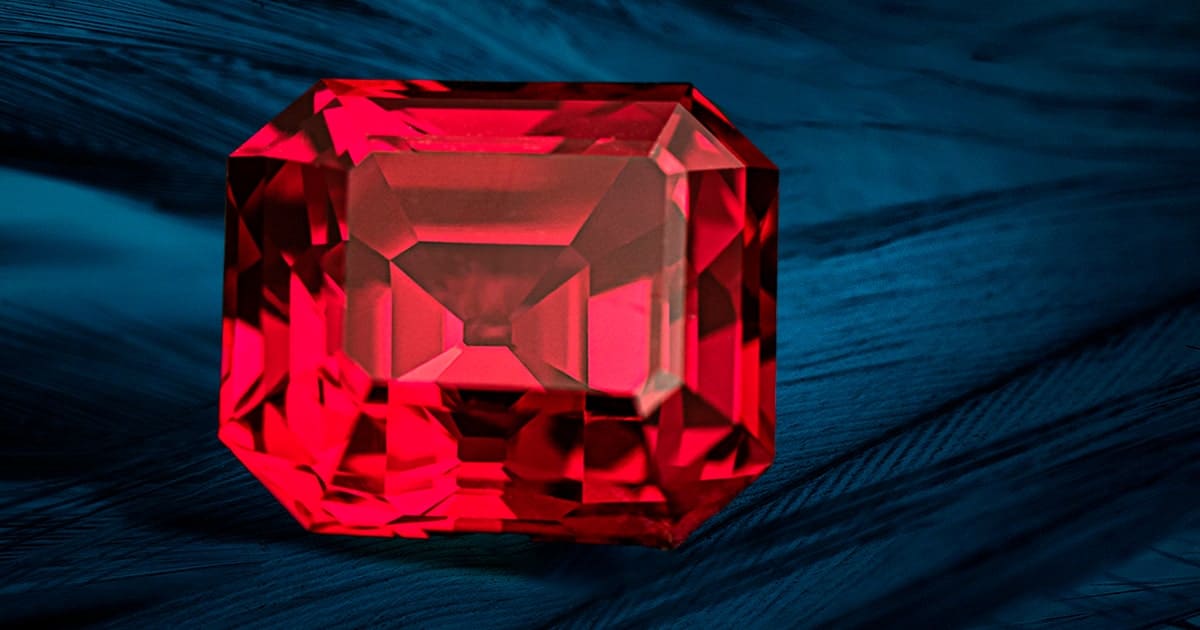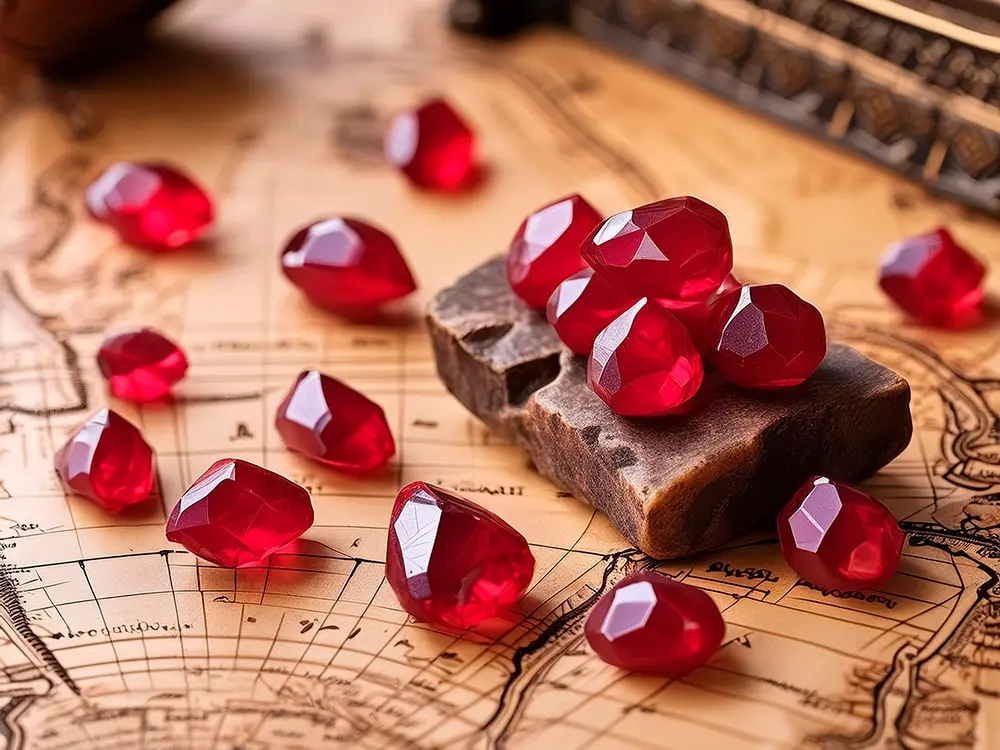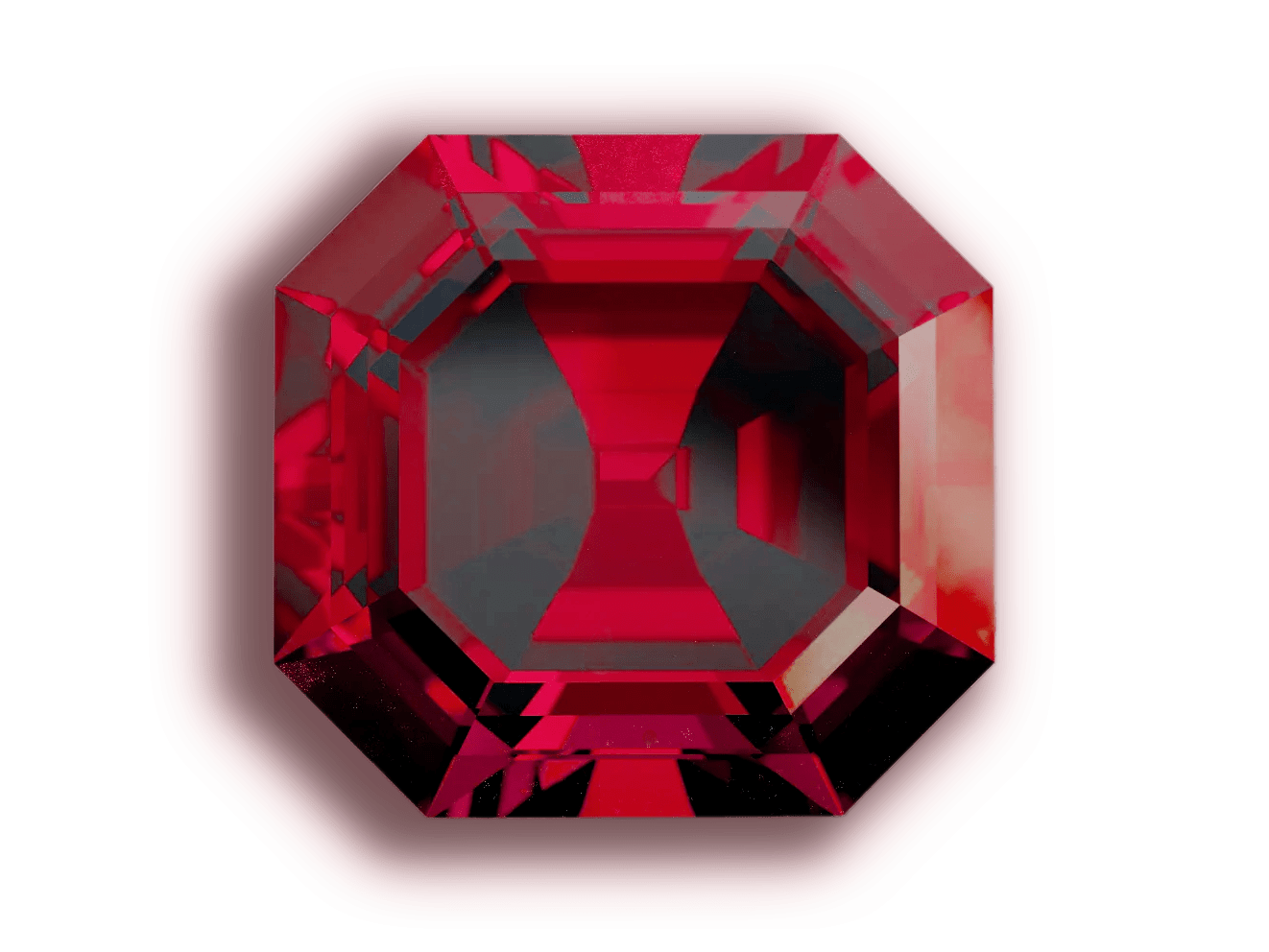The Enchanting World of Ruby Gemstones
“A drop of the heart’s blood of Mother Earth—ruby.” — Persian Proverb
Deep within the heart of Burma, where the ancient lands whisper tales of kings and warriors, lies the source of one of the world’s most revered gemstones: the Ruby. Known as the “King of Gemstones,” rubies have been prized throughout history for their intense red color, symbolizing passion, power, and protection. Legends say that warriors embedded rubies in their armor to make themselves invincible, while ancient Sanskrit texts referred to rubies as the “Ratnaraj” or “King of Precious Stones.”
Today, rubies continue to enchant us with their fiery beauty and rich history. In this blog, we’ll delve into the world of rubies, exploring their history, characteristics, and how to select the perfect ruby.
Description of Ruby
Rubies are a variety of the mineral corundum, colored red by trace amounts of chromium. Their intense red color, which can range from pinkish to purplish-red, is unparalleled in the gemstone world. The finest rubies are often called “pigeon’s blood” rubies, known for their deep, vibrant red with a hint of blue.
History and Journey of Rubies
Rubies have been treasured since ancient times. In India, they were known as the “Rajnapura” or “King of Gems.” Burmese warriors believed that rubies could make them invincible in battle. Rubies were also a symbol of wealth and power in many cultures, often used in royal insignia and crowns.
The Age of Rubies
Rubies form under intense heat and pressure deep within the Earth’s crust and can be billions of years old. These gemstones are brought to the surface through volcanic activity and are found in a few select places around the world.
Most Expensive Rubies
The Sunrise Ruby, weighing 25.59 carats, holds the record for the most expensive ruby ever sold at auction, fetching over $30 million. Its exceptional color and clarity set it apart as one of the most valuable gemstones in the world.
Fascinating Facts about Rubies
Did you know that rubies and sapphires are both varieties of the same mineral, corundum? The presence of chromium gives rubies their red color, while other trace elements result in the blue of sapphires. Rubies are also one of the hardest gemstones, second only to diamonds.
“Rubies, the heart’s own fire, sparkle with passion and promise.” — Unknown
Treatments, Synthetics and Imitations
Rubies often undergo treatments to enhance their appearance. The most common treatment is heat treatment, which improves color and clarity. It’s crucial to distinguish between natural, treated, synthetic, and imitation rubies.
- Heat Treatment: This is the most common treatment and is widely accepted in the industry. Heat treatment can enhance a ruby’s color and clarity by removing inclusions and intensifying the red hue.
- Fracture Filling: Rubies with surface-reaching fractures can be filled with glass or other substances to improve their appearance. This treatment should always be disclosed.
- Synthetics: Lab-created rubies have the same chemical composition and physical properties as natural rubies. They are more affordable and free from natural inclusions.
- Imitations: Imitation rubies can be made from various materials, such as glass or composite stones. They look similar to rubies but do not share the same properties.
Ruby as a Birthstone
Ruby is the birthstone for July, symbolizing passion, protection, and prosperity. It is also associated with the zodiac sign Cancer.
Why Love This Gemstone
Rubies are celebrated for their vibrant color, rarity, and hardness. They symbolize love and passion, making them a perfect gift for significant occasions. Their durability makes them ideal for everyday wear.
Quality Factors
1. Cut
The cut of a ruby is one of the most important factors affecting its beauty and value. Unlike diamonds, rubies are not graded on a standardized cut scale, but the quality of the cut significantly influences the gemstone’s brilliance, symmetry, and overall appearance.
Proportions: A well-cut ruby will have ideal proportions that maximize light reflection and brilliance. The cutter aims to create a balance between depth and surface area, ensuring that the ruby sparkles and shows its color evenly.
Shape: Rubies come in various shapes, with oval, cushion, and round cuts being the most popular. Fancy shapes like heart, marquise, and pear are also available but are less common. The choice of shape can impact the ruby’s appearance and how light interacts with it.
Symmetry: Good symmetry ensures that the ruby is balanced and that its facets are aligned properly. Symmetrical rubies exhibit better light performance and appear more visually appealing.
Polish: The polish quality affects the ruby’s surface smoothness and luster. A well-polished ruby will have a shiny, reflective surface that enhances its brilliance.
2. Clarity
Clarity refers to the presence of internal or external flaws, known as inclusions and blemishes, within the ruby. Unlike diamonds, inclusions in rubies are more common and are often accepted as part of the stone’s natural character. However, the visibility and number of inclusions can impact the ruby’s value.
Types of Inclusions: Common inclusions in rubies include rutile needles (silk), crystal inclusions, and color zoning. Some inclusions, like silk, can enhance the ruby’s appearance by causing a desirable optical effect called asterism, seen in star rubies.
Visibility: The best rubies have minimal inclusions that are not visible to the naked eye. Eye-clean rubies, which have no visible inclusions when viewed without magnification, are rare and highly valued.
Impact on Durability: Large or numerous inclusions can weaken the ruby’s structure, making it more susceptible to damage. It’s essential to consider clarity not just for aesthetics but also for durability.
3. Carat Weight
Carat weight measures the size of the ruby and significantly affects its price. Larger rubies are rarer and more valuable, especially those with excellent color and clarity.
Size vs. Weight: Carat weight does not always correspond to the ruby’s visual size. A well-cut ruby can appear larger than its carat weight suggests due to its proportions and cut quality.
Price Per Carat: The price per carat increases exponentially with the ruby’s size. For example, a 2-carat ruby of high quality can be significantly more expensive per carat than a 1-carat ruby of the same quality.
Impact of Cut and Shape: The cut and shape can influence how large a ruby appears. Certain cuts, like oval or marquise, can make the stone look bigger than its actual carat weight.
4. Color
Color is the most critical factor in determining a ruby’s value. The finest rubies display a pure, vibrant red to slightly purplish-red hue, known as “pigeon’s blood” red.
Hue: The hue refers to the basic color of the ruby. The most desirable hue for rubies is red. Variations in hue can include secondary colors like pink, orange, or purple.
Tone: Tone describes the lightness or darkness of the color. The ideal tone for a ruby is medium to medium-dark, as this range exhibits the richest and most vibrant color.
Saturation: Saturation measures the intensity of the color. High saturation means the color is vivid and pure, without any brown or gray modifiers. The best rubies have vivid saturation, resulting in a bright and intense red color.
Color Distribution: Even color distribution is crucial for a ruby’s appearance. Uneven color can create dark or light patches, detracting from the stone’s overall beauty.
Sourcing Places
The most renowned rubies come from Myanmar (Burma), particularly the Mogok region, known for producing “pigeon’s blood” rubies. Other significant sources include Thailand, Sri Lanka, and Mozambique.
Hardness and Durability
Rubies have a Mohs hardness of 9, making them extremely durable and suitable for everyday wear. However, they should still be protected from harsh impacts.
How to Buy a Ruby
When buying a ruby, prioritize color, clarity, and carat weight. Ask about any treatments and request a certificate of authenticity. Consider the stone’s cut and the overall appearance to ensure it meets your expectations.
Where to Get Rubies

Finding a trustworthy source to buy rubies is essential. Reputable jewelers, online retailers, gem shows, and auctions are good places to start. Always ask for a certificate of authenticity and detailed information about any treatments.
“for a curated selection of high-quality rubies, visit our website JewelNI. Our collection features rubies sourced from the best locations worldwide, with detailed information about each stone’s quality and treatments. Our expert team is here to help you choose the perfect ruby, ensuring you get the best value for your investment.”
Conclusion
- Rubies are mesmerizing gemstones with a rich history and unmatched beauty. Whether you’re looking to buy a ruby for yourself or as a gift, our site offers a curated selection that is sure to impress. Discover the allure of rubies and explore our exquisite range today!
- By following this guide, you’ll not only learn everything there is to know about rubies but also be inspired to add one to your collection. Explore the fiery beauty of rubies and let their passion and protection enhance your life.





